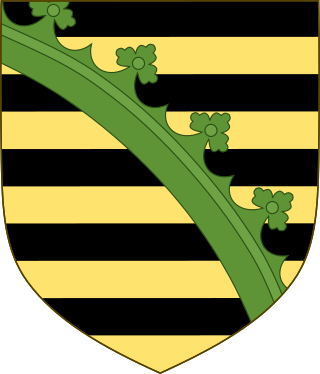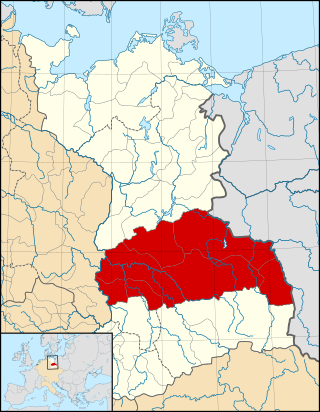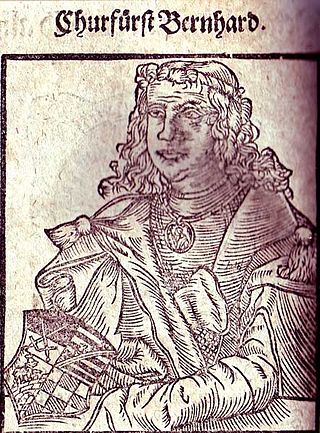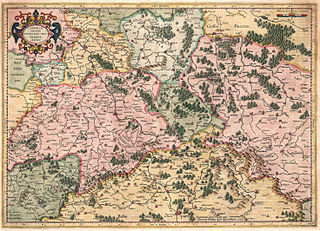This article lists the margraves of Meissen, a march and territorial state on the eastern border of the Holy Roman Empire.
This article lists the margraves of Meissen, a march and territorial state on the eastern border of the Holy Roman Empire.
King Henry the Fowler, on his 928–29 campaign against the Slavic Glomacze tribes, had a fortress erected on a hill at Meissen (Mišno) on the Elbe river. Later named Albrechtsburg , the castle about 965 became the seat of the Meissen margraves, installed by Emperor Otto I when the vast Marca Geronis (Gero's march) was partitioned into five new margraviates, including Meissen, the Saxon Eastern March, and also the Northern March which eventually became the Margraviate of Brandenburg.
During the tenth century, the Meissen margraves temporarily extended their territory into the Milceni lands up to the Kwisa (Queis) river and the border with the Silesian region of the Early Polish state. The eastern lands around Bautzen (Budissin), later known as Upper Lusatia, were ceded to the Polish duke Bolesław I the Brave according to the 1018 Peace of Bautzen; in 1076 they passed to the Duke of Bohemia as an Imperial fief.
From 1089, the Meissen margravial title became the honor of the Saxon House of Wettin and remained as the dynasty's possession ever since. In the 13th century the Meissen margraves acquired the former Pleissnerland territory and upon the War of the Thuringen Succession 1247–1264 also the adjacent Landgraviate of Thuringia in the west. Finally in 1423 Margrave Frederick the Warlike was enfeoffed with the Saxe–Wittenberg lands down the Elbe ('Upper Saxony'), an electorate according to the Golden Bull of 1356. While the Wettin rulers eventually moved their residence to Dresden, the Meissen margraviate merged into their electorate and became known as the 'Cradle of Saxony'.
| Affiliation | Name | Years | Comments |
|---|---|---|---|
| Wigbert | 965–970 | Received the Meissen territory upon the death of Margrave Gero | |
| Thietmar | 970–979 | Son of Count Christian of Serimunt, also Margrave of Merseburg | |
| Ekkeharding | Gunther of Merseburg [ dubious – discuss ] | 981–982 | also Margrave of Merseburg |
| Rikdag | 979–985 | since 982 also Margrave of Merseburg, removes Wigger in Zeitz, Gunther in Merseburg and Wigbert in Meißen as Margrave | |
| Ekkeharding | Eckard I | 985–1002 | Son of Gunther of Merseburg |
| Ekkeharding | Gunzelin | 1002–1009 | |
| Ekkeharding | Herman I | 1009–1031 | |
| Ekkeharding | Eckard II | 1031–1046 | |
| Weimar-Orlamünde | William | 1046–1062 | |
| Weimar-Orlamünde | Otto I | 1062–1067 | Died without male heirs |
| Brunonen | Egbert I | 1067–1068 | |
| Brunonen | Egbert II | 1068–1089 | Revolted against King Henry IV in 1076 |
| Přemyslid | Vratislaus II of Bohemia [ dubious – discuss ] | 1076–1089 | Enfeoffed by King Henry IV in turn for his support, though never confirmed |
| Wettin | Henry I | 1089–1103 | Son of Margrave Dedi I of the Saxon Ostmark, first Wettin ruler |
| Wettin | Thimo | 1103 | |
| Wettin | Henry II | 1104–1123 | |
| Wiprecht | 1123–1124 | ||
| Winzenburg | Herman II | 1124–1130 | |
| Wettin | Conrad | 1130–1156 | |
| Wettin | Otto II | 1156–1190 | |
| Wettin | Albert I | 1190–1195 | Followed by the direct rule of the Emperor Henry VI |
| Wettin | Dietrich I | 1198–1221 | |
| Wettin | Henry III | 1221–1288 | |
| Wettin | Albert II | 1288 | Son of Henry III the Illustrious |
| Wettin | Frederick I | 1291–1323 | |
| Nassau | Adolf | 1293–1298 | |
| Habsburg | Albert III | 1298–1307 | |
| Wettin | Frederick II | 1323–1349 | Son of Frederick I the Peaceful |
| Wettin | Frederick III | 1349–1381 | Son of Frederick II the Serious |
| Wettin | Balthasar | 1349–1382 | Son of Frederick II the Serious |
| Wettin | William I | 1349–1407 | Son of Frederick II the Serious |
| Wettin | George | 1381–1402 | Son of Frederick III the Strict |
| Wettin | William II | 1381–1425 | Son of Frederick III the Strict |
| Wettin | Frederick IV | 1381–1428 | Son of Frederick III the Strict |
| Wettin | Frederick V | 1407–1440 | Son of Balthasar, heir of William I |
After the abolition of all German monarchies in 1918 and the death of Friedrich August III, the last king of Saxony, in 1932, further heads of the house and pretenders to the throne have used the title Margrave of Meissen.

Meissen, is a town of approximately 30,000 about 25 km (16 mi) northwest of Dresden on both banks of the Elbe river in the Free State of Saxony, in eastern Germany. Meissen is the home of Meissen porcelain, the Albrechtsburg castle, the Gothic Meissen Cathedral and the Meissen Frauenkirche. The Große Kreisstadt is the capital of the Meissen district.

The history of Saxony-Anhalt began with Old Saxony, which was conquered by Charlemagne in 804 and transformed into the Duchy of Saxony within the Carolingian Empire. Saxony went on to become one of the so-called stem duchies of the German Kingdom and subsequently the Holy Roman Empire which formed out of the eastern partition of the Carolingian Empire. The duchy grew to become a powerful state within the empire, ruling over much of what is now northern Germany, but following conflicts with the emperor it was partitioned into numerous minor states, including the Principality of Anhalt, around the end of the 12th century and early 13th century. The territories of the Duchy of Saxony, the Principality of Anhalt, and their successors are now part of the modern German state of Saxony-Anhalt.

The House of Wettin was a dynasty of German kings, prince-electors, dukes, and counts that once ruled territories in the present-day German states of Saxony, Saxony-Anhalt and Thuringia. The dynasty is one of the oldest in Europe, and its origins can be traced back to the town of Wettin, Saxony-Anhalt. The Wettins gradually rose to power within the Holy Roman Empire. Members of the family became the rulers of several medieval states, starting with the Saxon Eastern March in 1030. Other states they gained were Meissen in 1089, Thuringia in 1263, and Saxony in 1423. These areas cover large parts of Central Germany as a cultural area of Germany.

Frederick II, The Gentle was Elector of Saxony (1428–1464) and was Landgrave of Thuringia (1440–1445).

Henry III, called Henry the Illustrious from the House of Wettin was Margrave of Meissen and last Margrave of Lusatia from 1221 until his death; from 1242 also Landgrave of Thuringia.

The Margravate or Margraviate of Meissen was a medieval principality in the area of the modern German state of Saxony. It originally was a frontier march of the Holy Roman Empire, created out of the vast Marca Geronis in 965. Under the rule of the Wettin dynasty, the margravate finally merged with the former Duchy of Saxe-Wittenberg into the Saxon Electorate by 1423.

The Electorate of Saxony, also known as Electoral Saxony, was a territory of the Holy Roman Empire from 1356–1806. Its territory included the areas around the cities of Dresden, Leipzig and Chemnitz.

The Diocese of Dresden–Meissen is a Latin Church diocese of Catholic Church in Germany with its seat in Dresden. It is suffragan to the Archdiocese of Berlin.

The Duchy of Saxe-Wittenberg was a medieval duchy of the Holy Roman Empire centered at Wittenberg, which emerged after the dissolution of the stem duchy of Saxony. The Ascanian dukes prevailed in obtaining the Saxon electoral dignity until their duchy was finally elevated to the Electorate of Saxony by the Golden Bull of 1356.

The Treaty of Leipzig or Partition of Leipzig was signed on 11 November 1485 between Elector Ernest of Saxony and his younger brother Albert III, the sons of Elector Frederick II of Saxony from the House of Wettin. The agreement perpetuated the division of the Wettin lands into a Saxon and a Thuringian part, which in the long run obstructed the further development of a Central German hegemonic power in favour of Brandenburg-Prussia.

The Saxon Eastern March was a march of the Holy Roman Empire from the 10th until the 12th century. The term "eastern march" stems from the Latin term marchia Orientalis and originally could refer to either a march created on the eastern frontier of the East Frankish duchy of Saxony or another on the eastern border of the Duchy of Bavaria: the Bavarian marchia Orientalis, corresponding to later Austria.
Conrad I, called the Great, a member of the House of Wettin, was Margrave of Meissen from 1123 and Margrave of Lusatia from 1136 until his retirement in 1156. Initially a Saxon count, he became the ruler over large Imperial estates in the Eastern March and progenitor of the Saxon electors and kings.

The March or Margraviate of Lusatia was an eastern border march of the Holy Roman Empire in the lands settled by Polabian Slavs. It arose in 965 in the course of the partition of the vast Marca Geronis. Ruled by several Saxon margravial dynasties, among them the House of Wettin, the lordship was contested by the Polish kings as well as by the Ascanian margraves of Brandenburg. The remaining territory was finally incorporated into the Lands of the Bohemian Crown in 1367.

Bernhard, a member of the House of Ascania, was Count of Anhalt and Ballenstedt, and Lord of Bernburg through his paternal inheritance. From 1180 he was also Duke of Saxony.

The Division of Altenburg was the plan for the division of the Meissen lands agreed upon by the two hostile Wettin brothers Elector Frederick II of Saxony and William III on 16 July 1445 at Altenburg. The brothers had attempted to reconcile, but eventually the division led the Saxon Fratricidal War, which began in 1446 and lasted for five years, until the Peace of Naumburg was negotiated in 1451. Following the peace, the subsequent Treaty of Eger in 1459, and the deaths of Frederick II and William III, the two sons of Frederick II eventually gained control of the land of both their father and William III.

The Saxon Fratricidal War was a war fought between the two brothers Frederick II, Elector of Saxony and Duke William III over Wettin ruled areas from 1446 to 1451. After a dispute over the division of certain family lands between Frederick II and William III, the Division of Altenburg eventually led to growing tensions between the two brothers and an inability to agree on who ruled which areas. After failed attempts at reconciliation, the war broke out and lasted for five years. The war was destructive and had no clear winner before being ended with a peace treaty at Naumburg. Following the war and subsequent divisions the Saxons lost much of their former power and influence within the different German states and families.

Upper Saxony was the name given to the majority of the German lands held by the House of Wettin, in what is now called Central Germany (Mitteldeutschland).

The Treaty of Eger, also called Main Compromise of Eger or Peace of Eger was concluded on 25 April 1459 in the Imperial City of Eger (Cheb), administrative seat of the immediate pawn of Egerland. The treaty established the border between the Kingdom of Bohemia and the Electorate of Saxony on the main ridge of the Ore Mountains stretching from Eger to the River Elbe. The border remains largely unchanged up to today, separating the Czech Republic and Germany, and is thus one of the oldest still extant borders in Europe.
The Duchy of Thuringia was an eastern frontier march of the Merovingian kingdom of Austrasia, established about 631 by King Dagobert I after his troops had been defeated by the forces of the Slavic confederation of Samo at the Battle of Wogastisburg. It was recreated in the Carolingian Empire and its dukes were appointed by the king until it was absorbed by the Saxon dukes in 908. From about 1111/12 the territory was ruled by the Landgraves of Thuringia as Princes of the Holy Roman Empire. When Frederick IV, the last independent ruler of Thuringia died in 1440, the territory passed to his nephew, the Saxon elector Frederick II.